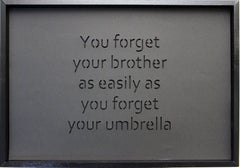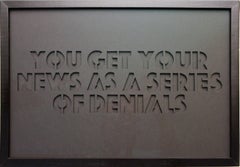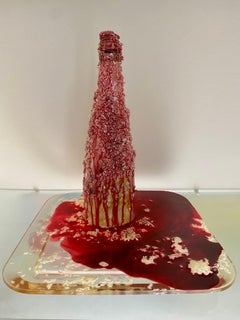Gil Scullion Art
to
7
7
Overall Height
to
Overall Width
to
7
7
6,909
3,240
2,514
1,217
7
Artist: Gil Scullion
Gil Scullion, Your Convictions, 2017, 20 sheets of stacked hand-cut paper
By Gil Scullion
Located in Darien, CT
Where do we come from? Where are we going? What the hell is going on here? 2017-2018 Hand cut paper in wood box
Gil Scullion’s conceptual text-based work has been featured in exhibi...
Category
2010s Conceptual Gil Scullion Art
Materials
Paper
Gil Scullion, You Walk, 2017, 20 sheets stacked hand-cut paper
By Gil Scullion
Located in Darien, CT
Where do we come from? Where are we going? What the hell is going on here? 2017-2018 Hand cut paper in wood box
Gil Scullion’s conceptual text-based work has been featured in exhibi...
Category
2010s Conceptual Gil Scullion Art
Materials
Paper
Gil Scullion, You First, 2017, 20 sheets of stacked hand-cut paper
By Gil Scullion
Located in Darien, CT
Where do we come from? Where are we going? What the hell is going on here? 2017-2018 Hand cut paper in wood box
Gil Scullion’s conceptual text-based work has been featured in exhibi...
Category
2010s Conceptual Gil Scullion Art
Materials
Paper
Gil Scullion, You Forget, 2017, 20 sheets of stacked hand-cut paper
By Gil Scullion
Located in Darien, CT
Where do we come from? Where are we going? What the hell is going on here? 2017-2018 Hand cut paper in wood box
Gil Scullion’s conceptual text-based work has been featured in exhibi...
Category
2010s Conceptual Gil Scullion Art
Materials
Paper
Gil Scullion, You Get, 2017, 20 sheets of stacked hand_cut paper
By Gil Scullion
Located in Darien, CT
Where do we come from? Where are we going? What the hell is going on here? 2017-2018 Hand cut paper in wood box
Gil Scullion’s conceptual text-based work has been featured in exhibi...
Category
2010s Conceptual Gil Scullion Art
Materials
Paper
Gil Scullion, You Need, 2017, 20 sheets of stacked hand-cut paper
By Gil Scullion
Located in Darien, CT
Where do we come from? Where are we going? What the hell is going on here? 2017-2018 Hand cut paper in wood box
Gil Scullion’s conceptual text-based work has been featured in exhibi...
Category
2010s Conceptual Gil Scullion Art
Materials
Paper
Gil Scullion, Your Existence, 2017, 20 sheets of stacked hand-cut paper
By Gil Scullion
Located in Darien, CT
Where do we come from? Where are we going? What the hell is going on here? 2017-2018 Hand cut paper in wood box
Gil Scullion’s conceptual text-based work has been featured in exhibi...
Category
2010s Conceptual Gil Scullion Art
Materials
Paper
Related Items
Banquet III-TimeCapsuleSeries-Resin Casting UK Awarded Artist-Conceptual Artist
Located in London, GB
The sculpture, Banquet III - Time Capsule Project , is one of the pivotal pieces showcased in the 2016 London exhibition titled “ White. It is within an on-going project by Shizico Y...
Category
2010s Conceptual Gil Scullion Art
Materials
Metal
H 10.24 in W 4.14 in D 4.14 in
Banquet II-TimeCapsuleSeries-Resin Casting- UK Awarded Artist-Conceptual Artist
Located in London, GB
The sculpture, Banquet II - Time Capsule Project , is one of the pivotal pieces in Shizico Yi's sculpture casting project.
By engaging with raw materials, familial possessions, and t...
Category
2010s Conceptual Gil Scullion Art
Materials
Metal
H 11.42 in W 11.42 in D 11.42 in
MIxed Media Conceptual Art Sculpture Drawing Human Rights Welded Iron
By Francoise Schein
Located in Surfside, FL
This is a large sculpture and also includes an artist custom framed silkscreen with extensive handwork titled Line of Time, pencil signed and inscribed, presented in heavy metal and wooden frame (framed piece 24.5 x 30 in., sculpture piece is about 94 X 11 inches)
Francoise Schein is a visual artist, trained as an architect - urban planner; She also teaches art at the ESAM Higher School of Arts and Media in Caen in Normandy . She is the founder of the INSCRIRE Association.
In 2016, she was elected member of the Royal Academy of Sciences, Arts and Fine Arts of Belgium.
Group Exhibitions
Spain: 2016, The "5Contemporary" Paris gallery presented a group show at the Museum of Contemporary Art of Genalguacil, Spain. The show included important artists such as Françoise Schein, Mimouni and Pedro Castrortega.
Born in Brussels , Françoise Schein left Belgium after studying architecture at the higher institute of architecture of the French community - La Cambre where she wrote her thesis on fundamental rights, then studied urban design at the Columbia University in the City of New York . She lived 11 years in New York where she begins a work on cartography territories. Subway map Floating on NY Sidewalk is his first monumental urban sculpture located at 110 Greene Street in SoHo (1985). At that time her works are abstract landscapes of cities, made up of networks, lines, trajectories, territories, founding texts and stories. They are constructed of very diverse materials and light.
Returning back to Europe in 1989, she continues to work on what she calls her drawings-laboratories while beginning to integrate works in cities on civic themes, the main ones: at the Concorde metro station in Paris in 1991 and then in Brussels, Saint-Gilles , in 1992, these two projects took her to Lisbon in 1993 where she lived for five years and produced two monumental works (in azulejos) for the city of Lisbon at Parque metro station ( 1994) and another for the city of Stockholm at the Universitetet station (1998). She continues to travel to cities where she builds successively projects in Haifa , on the facade of the Beth Hagefen Jewish-Arab Cultural Center with Michel Butor (1994). Then she lives in Berlin where she builds the Westhafen station (2000) which takes her to Bremen to make her first human rights park, Rhododendronpark (2002). In 2005, she made the monumental Time Zone Clock in Coventry in 2005. Since 1999, she has also settled in Rio de Janeiro and initiated participatory artistic projects with the underprivileged population of the favelas . Since then, with the help of a locally trained team, many projects have been carried out, including one in Copacabana and more than 20 in different favelas (from 1999 to 2016). These works transformed the Rio workshop into sustainable development for the people who invested it. In Sao Paulo, since 2009, Françoise Schein has produced a monumental work with the participation of 1000 young people from the favela schools at Luz subway station.
Her work is monumental recalling the works of Christo, Maria Dompe, Christian Boltanski, Anish Kapoor, Ai Wei Wei...
Category
Late 20th Century Conceptual Gil Scullion Art
Materials
Iron
Stripes 2
By Lyn Carter
Located in Buffalo, NY
An original conceptual wall sculpture by contemporary Canadian female artist Lyn Carter.
Lyn Carter works primarily in sculpture as well as drawing and has exhibited across Canada...
Category
2010s Conceptual Gil Scullion Art
Materials
Fabric, Wood, Digital
Chimera Bad
By Niki Singleton
Located in Los Angeles, CA
Acrylic, oil, paper collage, car side mirror, branches, chimes, rag,
clock radio
(Instructions: Press “on” button on side of radio to turn on. Tune to suitable station)
A pa...
Category
21st Century and Contemporary Conceptual Gil Scullion Art
Materials
Acrylic, Mirror, Mixed Media, Oil, Rag Paper
Resin Abstract Circle Sculpture: 'Circle'
By Kelly Bugden + Van Wifvat
Located in New York, NY
The artistic collaboration of Kelly Bugden + Van Wifvat has produced a thought-provoking body of sculptures, paintings, and constructions. Nature, childhood memories, and everyday archetypes take shape in unexpected combinations of materials. The works emerged as the tactile and visual senses channeled the ritualistic power and materiality of selected artifacts.
The resulting objects exist in a space between what they were originally and what they could become. A wheel, for example, is distorted as if seen through a prism. Their collaboration grew out of years of shaping materials into one-of-a-kind objects. Intuitively, the process of creating with their hands took an inward turn. Prism is a travelogue through memories and dreams, yielding abstract forms that capture moments of transformation.
Van Wifvat grew up with eight siblings and studied sculpture and environmental design in Minneapolis at MCAD. In 1979, he opened a storefront art gallery to promote the work of local artists. The space featured printed materials—art books, periodicals, fanzines, and postcard’s. Wifvat moved to New York in 1983 to study at the Fashion Institute of Technology and Parsons. In 1987, he co-founded Van Gregory & Norton design studio, specializing in convex mirrors and curtain hardware...
Category
2010s Conceptual Gil Scullion Art
Materials
Ceramic, Resin, Wood, Glaze, Handmade Paper
Wood equals paper
By Dianne Baker
Located in Buffalo, NY
A contemporary collection of conceptual wall sculptures by Dianne Baker titled "Wood = Paper" created in 2016 with wood, metal, leather and handmade paper.
Various Sizes:
16" x 1...
Category
2010s Conceptual Gil Scullion Art
Materials
Metal
Russian Samizdat Art Conceptual Compass Sculpture Assemblage Gerlovin, Gerlovina
Located in Surfside, FL
Rimma Gerlovina and Valeriy Gerlovin
Compass, 1988
Aluminum sculpture, mixed media and c-print photograph construction, c-print, felt tip marker
12.5 h × 12.5w × 4 d in (30 × 30 × 6 cm)
Rimma Gerlovina and Valeriy Gerlovin were founding members of the underground conceptual movement Samizdat in the Soviet Union, described in their book Russian Samizdat Art. Based on a play of paradoxes, their work is rich with philosophic and mythological implications, reflected in their writing as well. Their book Concepts was published in Russia in 2012. The work by Rimma Gerlovina and Valeriy Gerlovin is emphatically contemporary. The artist couple were part of the Moscow Conceptualists, their performance Costumes, from 1977, deepened their ongoing work with linguistic semiotic systems and their own bodies. Considering the context in which Gerlovina and Gerlovin made their work—that of political restrictions on public life, of unfreedom, and censorship—their collaborative togetherness must also be read as a space of possibility for political community and resistance. Rimma Gerlovina’s hair is featured prominently in the art of the Gerlovins as a constructing element of the body. Used for the linear drawings her braids transmit transpersonal waves reminiscent of an aura of live filaments. Long loose hairs function as threads of life; streaming in abundance, they allude to Aphrodisiac vitality and Samsonian strength. On the other hand, they are the haircloth worn during mourning and penitence. In New York they continued to make sculptural objects, and their photographic projects grew into an extended series called Photoglyphs. In their photographs, they use their own faces to explore the nature of thought and what lies beyond it. Since coming to the United States in 1980, they had many exhibitions in galleries and museums including the Art Institute of Chicago. The New Orleans Museum of Art launched a retrospective of their photography, which traveled to fifteen cities. Group exhibitions include the Venice Biennale, the Guggenheim Museum, New York, Smithsonian National Museum of American Art, Washington D.C., Bonn Kunsthalle, Germany, Tokyo Metropolitan Museum of Photography, State Tretyakov Gallery, Moscow, and others.
Samizdat or “self-published” began in the Soviet Union, and Samizdat art consists mainly of books and magazines published and distributed by the artists who made them. Samizdat art has sources in the innovative books and magazines turned out by the early 20th century Russian avant-garde—artists and writers like Olga Rozanova, Vladimir Mayakovsky, El Lissitzky, and Alexander Rodchenko.
Artists as varied as Alexander Archipenko, Leon Bakst, Marc Chagall, Naum Gabo, Alexandra Exter...
Category
1980s Conceptual Gil Scullion Art
Materials
Metal
Sculpture; 'Portal'
By Kelly Bugden + Van Wifvat
Located in New York, NY
The artistic collaboration of Kelly Bugden + Van Wifvat has produced a thought-provoking body of sculptures, paintings, and constructions. Nature, childhood memories, and everyday archetypes take shape in unexpected combinations of materials. The works emerged as the tactile and visual senses channeled the ritualistic power and materiality of selected artifacts. The resulting objects exist in a space between what they were originally and what they could become. A wheel, for example, is distorted as if seen through a prism. Their collaboration grew out of years of shaping materials into one-of-a-kind objects. Intuitively, the process of creating with their hands took an inward turn. Prism is a travelogue through memories and dreams, yielding abstract forms that capture moments of transformation.
Van Wifvat grew up with eight siblings and studied sculpture and environmental design in Minneapolis at MCAD. In 1979, he opened a storefront art gallery to promote the work of local artists. The space featured printed materials—art books, periodicals, fanzines, and postcard’s. Wifvat moved to New York in 1983 to study at the Fashion Institute of Technology and Parsons. In 1987, he co-founded Van Gregory & Norton design studio, specializing in convex mirrors and curtain hardware...
Category
2010s Conceptual Gil Scullion Art
Materials
Gold Leaf
Gentleman, Marble and Travertine Conceptual Sculpture
By Maria Dompe
Located in Surfside, FL
MARIA DOMPE, (Italian, b. 1958), Gentleman Sculpture, marble and travertine, 1995, height: 20 in.
One of a pair, (Gentleman and Lady) being sold separately.
Maria Dompe was born in ...
Category
Late 20th Century Conceptual Gil Scullion Art
Materials
Travertine, Marble
Russian Samizdat Art Conceptual Photo Sculpture Assemblage Gerlovin & Gerlovina
Located in Surfside, FL
Rimma Gerlovina and Valeriy Gerlovin
Clock, 1987-94
Aluminum sculpture, mixed media and c-print photograph construction, c-print, felt tip marker
13 h × 13 w × 4 d in (30 × 30 × 6 cm)
Rimma Gerlovina and Valeriy Gerlovin were founding members of the underground conceptual movement Samizdat in the Soviet Union, described in their book Russian Samizdat Art. Based on a play of paradoxes, their work is rich with philosophic and mythological implications, reflected in their writing as well. Their book Concepts was published in Russia in 2012. The work by Rimma Gerlovina and Valeriy Gerlovin is emphatically contemporary. The artist couple were part of the Moscow Conceptualists, their performance Costumes, from 1977, deepened their ongoing work with linguistic semiotic systems and their own bodies. Considering the context in which Gerlovina and Gerlovin made their work—that of political restrictions on public life, of unfreedom, and censorship—their collaborative togetherness must also be read as a space of possibility for political community and resistance. Rimma Gerlovina’s hair is featured prominently in the art of the Gerlovins as a constructing element of the body. Used for the linear drawings her braids transmit transpersonal waves reminiscent of an aura of live filaments. Long loose hairs function as threads of life; streaming in abundance, they allude to Aphrodisiac vitality and Samsonian strength. On the other hand, they are the haircloth worn during mourning and penitence. In New York they continued to make sculptural objects, and their photographic projects grew into an extended series called Photoglyphs. In their photographs, they use their own faces to explore the nature of thought and what lies beyond it. Since coming to the United States in 1980, they had many exhibitions in galleries and museums including the Art Institute of Chicago. The New Orleans Museum of Art launched a retrospective of their photography, which traveled to fifteen cities. Group exhibitions include the Venice Biennale, the Guggenheim Museum, New York, Smithsonian National Museum of American Art, Washington D.C., Bonn Kunsthalle, Germany, Tokyo Metropolitan Museum of Photography, State Tretyakov Gallery, Moscow, and others.
Samizdat or “self-published” began in the Soviet Union, and Samizdat art consists mainly of books and magazines published and distributed by the artists who made them. Samizdat art has sources in the innovative books and magazines turned out by the early 20th century Russian avant-garde—artists and writers like Olga Rozanova, Vladimir Mayakovsky, El Lissitzky, and Alexander Rodchenko.
Artists as varied as Alexander Archipenko, Leon Bakst, Marc Chagall, Naum Gabo, Alexandra Exter...
Category
1980s Conceptual Gil Scullion Art
Materials
Metal
Monocromo rojo quemado
By Eduardo Costa
Located in Mexico City, CDMX
Eduardo Costa is one of the key figures in global conceptual art. He was born in Buenos Aires in 1940. He graduated in Literature and Art at the University of Buenos Aires in 1965 where he took courses with Jorge Luis Borges in the late fifties. His practice developed into Conceptual POP with the Fashion Fictions Series, 1966-to the present. He is also credited with creating Conceptual Geometry which he showed internationally starting in 1995 at the Elga Wimmer Gallery, NY, and in 2001 at Cecilia de Torres LTD., NY. With Cecilia de Torres he exhibited a fully developed edition of his Volumetric Paintings, which use painting to such a volume that it stands by itself without any cloth or other support.Eduardo Costa lived twenty-five years in New York and over four years in Rio de Janeiro where he met almost daily with Hélio Oiticica, Lygia Pape...
Category
2010s Conceptual Gil Scullion Art
Materials
Acrylic
Gil Scullion art for sale on 1stDibs.
Find a wide variety of authentic Gil Scullion art available for sale on 1stDibs. You can also browse by medium to find art by Gil Scullion in paper and more. Not every interior allows for large Gil Scullion art, so small editions measuring 22 inches across are available. Customers who are interested in this artist might also find the work of Kathleen Vance, Katherine Jackson, and Eduardo Costa. Gil Scullion art prices can differ depending upon medium, time period and other attributes. On 1stDibs, the price for these items starts at $667 and tops out at $667, while the average work can sell for $667.






